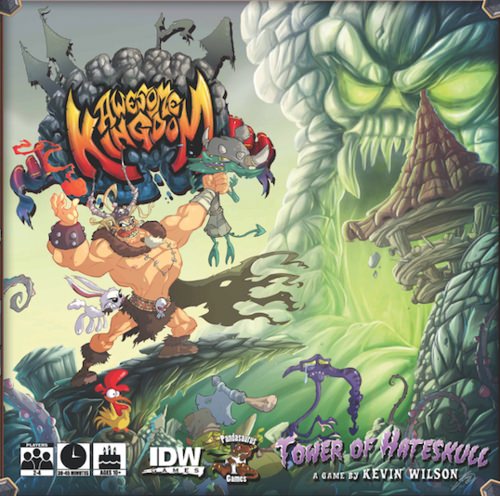The Last Spike board game review
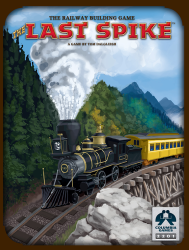
Living in Utah we’re very familiar with the history behind connecting the Transcontinental Railroad in 1869.
In May of that year, the “Last Spike” was driven home in Promontory Summit, Utah. Doing so created a 1,907-mile (3,069 km) contiguous railroad line connecting the Pacific coast with the existing eastern U.S. rail network.
So when we heard about a new board game called The Last Spike, we immediately knew what it would be about.
What we didn’t know however was if the game would be fun.
And there’s no better way to find out than to play it.
How to Play The Last Spike
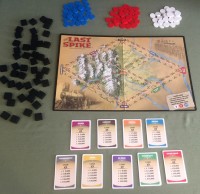
The Last Spike is a pretty straight forward and easy to learn board game.
In the game, players cooperate to build a continuous railway from St. Louis to Sacramento.
Yet this isn’t a cooperative board game where everyone works together for a shared victory. Instead players are competing against each other to earn the most money by the end of the game.
Players earn money by buying land cards that will payout when rail lines are completed to those cities. But not every city needs to be connected. So some will payout and others won’t. Thus players speculate which land will be most valuable throughout the game and work to buy the associated land cards.
It’s a fun balance of cooperation and competitiveness that drives the game.
Set Up
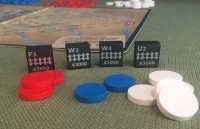
To begin, all the railway track tiles are turned face down and shuffled around. Then each player draws 4 tiles as their starting hand and keeps them secret.
Each player also gets a set amount of money depending on the number of players in the game. For example, in a 4-player game each player starts with $40,000.
Each of the 9 cities represented on the game board has 5 associated land cards. These are placed in land card stacks with the cheapest on the top to the most expensive on the bottom. The “Land 0” card is placed on the top of each stack.
Taking a Turn
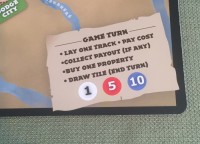
One of the cool things about the game board is the Game Turn and Chip Value reminder in the bottom right corner. So if anyone needs a reminder of what to do on their turn, one quick glance will help spur their memory.
1. On a player’s turn they must first lay one railway track tile on the game board map.
Each track tile contains a unique letter and number and must be placed on the corresponding spot on the map. The player then pays the cost of laying that track tile to the bank. For example, the tile W4 must be placed on the W4 spot on the board (next to Yuma) and costs $1,000 to place.
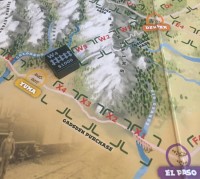
Tiles should be placed next to either a city or an existing track tile. Because if they aren’t placed next to either of those, then the cost will be double what’s on the tile! After all, it’s more expensive to lay track out in the middle of nowhere.
The cost of laying track varies to reflect terrain such as bridges or tunnels through mountains. For example, the tile V2 costs $6,000 to place because it’s going through the Rocky Mountains.
If a player can’t pay the cost of laying a track, they must sell land to the bank for half cost. (And yes that that does hurt when it happens.)
The first player to lay track next to a city gets the top land card for that city for free (“Land 0” card).
2. After laying a track tile, the player may then purchase 1 land card of their choice.
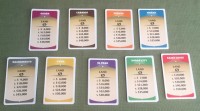
Of course, if they’ve claimed the top card of a city stack on that turn, that is their 1 land card for that turn and cannot purchase another card.
Also, players can’t purchase land for a city until its free land card has been taken.
To purchase a land card, a player must pay the “Land” price noted at the top of the card. As land cards are purchased during the game, subsequent land cards become more expensive.
3. The last thing a player does on their turn is draw one new track tile.
Thus, they should again have 4 track tiles in hand and can start planning their tile placement for their next turn.
Payouts
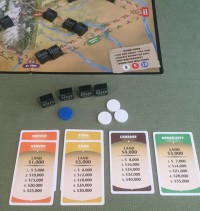
Laying track is all well and good, but a player’s money will dry up pretty quickly without making some money from the routes.
If laying a track tile completes a section between two cities, all players who own land (cards) of those cities will receive their payouts from the bank.
The amount paid to each player depends on the number of land cards held for the connected cities. If a player owns 2 land cards of a city, they collect the amount listed next to the “2”.
For example, having 2 Denver land cards means that player will collect $10,000 when a route connecting Denver is completed. Since Denver is in the center of the board, it could potentially payout 4 times during the game.
End of Game
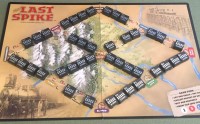
The game ends when the Last Spike is played. This is the track tile that makes a complete connection of the railway from St. Louis to Sacramento. Playing the last spike earns the player a $20,000 bonus!
After that tile is played, the payout for the two connected cities on that section is collected.
Players then total their money and the player with the most wins the game!
Can the whole family enjoy The Last Spike?
The Last Spike is a great family board game.
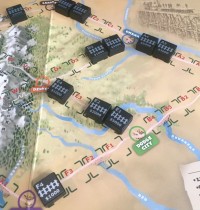
It has the spirit of both cooperation and competition and makes for some interesting dynamics throughout the game.
The recommended age range is 10+ and we think that’s pretty accurate. We’d guess kids younger than 10 will enjoy playing with the rest of the family as long as they can understand the element of buying land cards and receiving payouts.
While very young kids may not have a problem matching a track tile to the correct spot on the game board map, they may not catch the nuances of when to play which tiles.
But older kids and adults can really get into those elements which make up the heart of the game.
What we like about The Last Spike
As you might have guessed, we really like the choices players are faced with in The Last Spike.
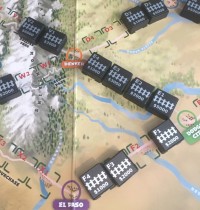
While the rules are simple and easy to learn, the draw of the game is the balance between the cooperation and the competitiveness.
Eventually one complete route will connect St. Louis to Sacramento. But which cities will it go through? And when will those cities connect?
Since players have all their owned land cards face up in front of them, it’s easy to see which cities each player would like to see connected. For example, if Jaden has 3 El Paso land cards and I don’t have any, I’m not likely to help connect a route that goes through El Paso.
And if I’m getting low on money, it’s in my interest to get a city connected soon. And that may benefit another player as well.
It’s a tricky balance and one that’s a lot of fun to contemplate.
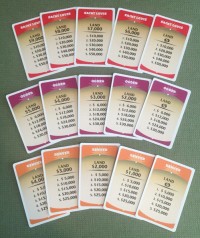
Yet, the game has a fair amount of luck involved as well.
After all, the 4 tiles in my hand are all that I have to choose from each round. The luck of the tile draw definitely impacts the options available to each player.
But players can also work around those tile draws to their advantage. It may be helpful to hold onto certain, critical tiles until later in the game for maximum impact.
Perhaps the funnest part of the game for us is the speculation on which land cards to purchase.
While the board layout and cost of each track tile is set, there’s still variability from game to game because of which land cards players tend to snatch up. Watching what other players are buying can give hints to which track tiles they may have.
Do you want to get the land cards that have less chance of completing a connection but with a higher payout when they do? Or do you want to claim land cards that have a lower payout but a higher likelihood of being completed?
And when is the right time to stock up on certain land cards?
They’re less expensive near the beginning of the game, but the land is also wide open. By the time it’s more clear on which cities may get connected, the cost of those land cards will be more expensive.
It may all depend on where the rail lines are being placed.
And that unknown factor makes for quite a fun game.
Oh, and another reason we think it’s a great family board game is that it can be played with 6 players. And we always like finding games that we can all play together.
How does The Last Spike score on our “Let’s Play Again” game meter?
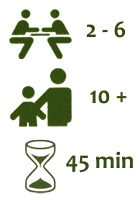 The Last Spike scores in about the middle of our “let’s play again” game meter.
The Last Spike scores in about the middle of our “let’s play again” game meter.
It has the great balance of strategy and luck that we like in a family board game. And with a play time of about 30 minutes it’s in the sweet spot of a good amount of time enjoying a game together.
While we haven’t played games of The Last Spike back-to-back, it’s nice that when we pull it out to play again we don’t have to get a major refresh on the rules. It’s so straight forward that it’s easy to simply set up and get playing.
Thanks Columbia Games for a great family board game!


